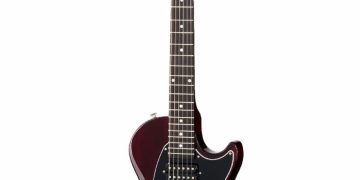 In 1922, Henry and Julius Grossman founded Grossman Brothers Music Company as wholesalers of musical instruments and accessories. The Cleveland, Ohio-based operation was soon joined by brother-in-law Max Berger and, afterwards, by Max’s son Joseph who served as a travelling salesman.
In 1922, Henry and Julius Grossman founded Grossman Brothers Music Company as wholesalers of musical instruments and accessories. The Cleveland, Ohio-based operation was soon joined by brother-in-law Max Berger and, afterwards, by Max’s son Joseph who served as a travelling salesman.
The company flourished in the following decades, expanding into manufacturing – notably the Flutophone, a one-octave clarinet style instrument for children which has now sold a staggering fifty million-plus units, worldwide – and acquiring Trophy Plastics in 1949 (later changed to Trophy Music Company). 1952 saw a significant development for the organization with the purchase of A.D. Grover & Son, a brand that dates back to the late 19thcentury and which had already developed a fine reputation for machine heads for fretted instruments and violins. Grover’s innovative enclosed Rotomatic tuners quickly became an industry standard and remain the go-to choice for many players, professional and hobbyist, alike.
2022 marks Grover Musical Products, Inc.’s 100th anniversary – a rarely achieved milestone in any industry, including MI. MMR recently touched base with president Cory Berger to learn more about the company’s past, its current projects, and hopes for the future.
Back in those early days, where was the first brick-and-mortar location and how many employees were there, total?
21 West St. Clair, Cleveland Ohio, 44115. Unfortunately, at this time, we are unsure as to how many employees there were, as that generation is no longer with us.
After a successful early run in the original incarnation of the business with a number of expansions, the company decided to go into manufacturing. What brought about this change to the business model?
The company was originally a wholesale distributor only. As items became difficult to get, or not made available to Grossman and with many new items on the horizon, it was decided to begin manufacturing and selling to other distributors
The shift into manufacturing dovetailed into the acquisition of Trophy Plastics – the first of a number of significant acquisitions for the company. What were some of Trophy’s early successes in the manufacture of novelty instruments and musical toys?
As the company grew, it began to expand into manufacturing, with the first production item being the Flutophone, a one octave clarinet style instrument for children’s introduction to music, which to date, has sold over fifty-million units worldwide. The Flutophone was originally molded at Trophy Plastics, a local company which Grossman acquired in 1949 – later changing the name to Trophy Music Company. Trophy began to manufacture several other musical toys, plastic novelty instruments. Some of the more memorable items include the SousaFun, the Toy Trumpet, Hum-A-Zoo and Slide Whistles, many of which can still be found in the market today.
Probably the most significant acquisition was the purchase of A.D. Grover & Son in 1952. How did that development come about?
Unfortunately, some of this history has been lost over time, but it is our understanding that we were approached by A.D. Grover & Son, as we had already been selling their products since Grossman brothers first opened shop.
Other brands were brought into the fold: Rogers Drums, Clevelander Drum Co., et cetera. What was behind such rapid expansion?
There was quick success of manufacturing and supplying distributors which led to new product ideas from within the company, along with suggestions from outside sources. Also, companies were researched by us to pursue, and some came to us to either buy them out or manufacture and private label for them.
Of the products from all of the lines, looking back on the first 100 years, what were some of the most significant milestone moments, product introductions, and partnerships?
Certainly, reaching our 100-year anniversary under four generations of the same family ownership is something we are very proud of. Grover and Rogers are the biggest success-stories for us. Working directly with musicians such as Buddy Rich, Louis Belson, and Roy Burns, along with so many guitarists who insist upon Grover tuners for their guitars has made our business very interesting, educational, and fun.
Can you describe the current Grover/Trophy facilities and distribution model? How many employees are there, total, in 2022?
Located in Cleveland, Ohio, our headquarters is a 40,000-square foot, freestanding building containing office and warehouse space. This is our sixth location since the beginning of the business and there is land to add on, should it become necessary.
We have a very dedicated staff, many of whom have been with the company for 15 or more years and we would like to give special recognition to everyone, both past and present, who have made our 100th anniversary possible: Richard Berger (CEO), Cory Berger (President), Dan Greene (Controller), Kevin Skutt (General Manager), Olga Jareb (Office Administrator), Sam Marchuk (Client Service Manager), Evan Mitchell (Clevelander Specialist), Dorothy Lo (Receptionist). The warehouse/shop staff includes: Bob Ori (Warehouse Supervisor), Ryan Milanko (Shop Manager), Sue, Mike, Curtis, Bob, and Tan
Do you have any promotions, events, or initiatives planned to celebrate this centennial milestone?
COVID-19 has unfortunately delayed any currently celebrations, but we hope to host a cocktail hour for all of our valued partners at Summer NAMM 2022.
Expectations for the coming months – both for Grover/Trophy and the MI industry, as a whole?
Although COVID-19 has created challenges, we have been diligently working on a number of new projects over the last few months and hope to make some big announcements by year’s end. Our industry is strong, and many people turn to music during difficult times.

























